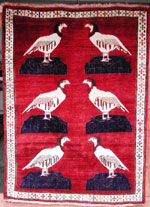|
Gabbeh History
The word Gabbeh is of Persian origin, and is found in current usage in the dialects of Fars Province. According to the definition given for Gabbeh in the standard Persian dictionaries, it is a kind of carpet with "long weft" (meaning long pile - knotted pile in GAbbeh is, in effect, a supplementary weft).
Some other dictionaries consider it synonymous with Khersak. Which is another type of long-piled rug.
The Oldest Gabbeh Document
The oldest document that refers to Gabbeh's dates back to the sixteen Century A.D. It is a decree of Shah Tahmasp, The Safavid ruler (1524-1576), concerning a reception to be provided for Humayun, The Mugal emperor of India, who had sought refuge in Iran in 1540.
In setting out detailed instructions for Humayun's reception, the decree reads:
And we have ordered a silk tent to be ordered a silk tent to be set up for the kitchen near the royal pavilion and the private quarters, covering the ground with silken carpets from Khorasan, with Gabbeh's, with felts from Jam, and with suzanis (embroideries).
The short reference to Gabbeh's, which is found in the above passage, suffices to discredit some of the theories that have been advanced about the Gabbeh, such as being a floor covering of poor people, or its being new phenomenon and product of the last two or three centuries.
Shah Tahmasp's decree, in which he orders the floor of Humayun's pavilion to be covered with silk carpets from Khorasan, and with fine felts from jam, and embroideries and Gabbeh, provides us with proof that in the distant past the Gabbeh has been a valued and aristocratic floor covering on a par with silk and embroideries.
GABBEH introduced to the West.
It is no coincidence that a picture collector like Georges D. Bornet in Europe and an artist like Parviz Tanavoli in Persia were among the first people to be deeply interested in Gabbeh's. But literature about them remains very scarce. There was no book until now which dealt exclusively with them. Without The Bornet Collection this would be still impossible. Parviz Tanavoli shows a number of lion Gabbeh in his book "Lion Rugs of Fars." Tanavoli has also written an article in Hali (Vol.5 No.4) illustrating three beautiful abstract pieces. The same addition also has an article about the Bornet Collection by Douglas W. Martin, who has worked on Gabbeh carpets for years.
|
| Who is making Persian GABBEH? |
 |
|
| Our Weekly Special |

Bird Gabbeh |
|

